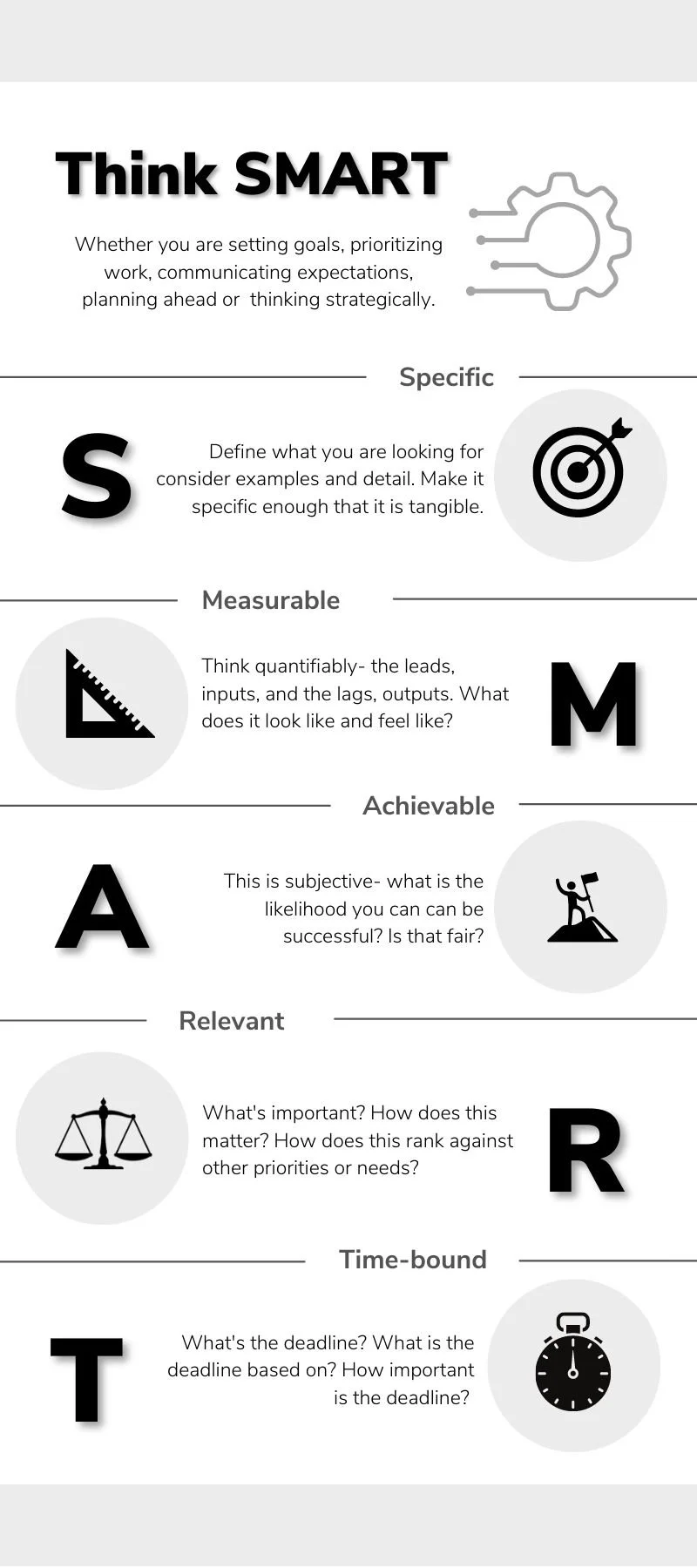Setting Actionable Goals: Think SMART
Use SMART, leads, and lags to define more specific and actionable goals, so your team knows how to achieve results.
Tool Summary
SMART is a framework to help think, define and communicate work, expectations, projects, and goals more strategically. The acronym stands for Specific, Measurable, Achievable, Relevant, and Timebound.
How to Apply
To begin thinking SMART you need to make time to pause and reflect. Start by asking yourself these five questions:
S - What am I working on? (Specific)
M - How will I know if I am successful? (Measurable)
A - How likely am I to be successful? (Achievable)
R - How is this important? (Relevant)
T - What is my deadline? (Time-bound)
Save these five questions and use them anytime you need direction, clarity, prioritization, or alignment.
You can apply the SMART framework to your own goals and work as well as team goals and work. When you are working with others, would all of the answers to these questions be the same? Where should they differ and where should they align?
Measuring Results
To measure results, dive deeper into each category.
Specific:
Specificity, details, or definition is one of the key things that help to avoid procrastination and create alignment with others. If your work is too vague, you may find it challenging to get things done or you may find yourself misaligned or miscommunicating with others. The more specific things are defined, the easier it is to know what you are working on individually or as a group.
Measurable:
Goals should be measurable. The ability to measure progress and achievement of a goal on a defined scale helps with alignment and clarity on what a successful outcome looks like objectively. Measurement also helps with everyday tasks and expectations to mitigate procrastination. Measurement creates a clearer view of progress, impact, and priorities. To make things more measurable consider:
What are the lead measures, or inputs?
What am I doing to contribute to the success of my work?
What is my role?
What am I expecting my team members to do?
What are the lag measures, or outputs?
If I am successful what happens differently?
How will I know?
How am I reviewing if others are successful?
In either of these, you can track the objective measures you can see or the subjective measures you can feel.
If you are successfully thinking about “measurability” you have a clear definition of success, a path to get there, and know when you have made progress.
Achievable:
Your goals, work, and expectations should be achievable. If success seems unlikely, it becomes easier to procrastinate. Determining how achievable work or goals are can be subjective. You may look at the situation differently than someone else. Your abilities, personal values, and standards impact what a stretch goal and what an easy goal looks like to you. What is achievable to you, may not be as achievable to someone else. Achievable goals should be challenging enough but not too challenging. Talk to your team members and other stakeholders to define achievable success.
When considering achievability, you also need to take into account any variables and factors that impact success, are in control, and are out of control.
Relevant:
Why does the work or goal matter? When you think about relevance, you need to consider impact and importance. You should feel like what you are working on matters, will have an impact, and is worth doing. If you do not see how and why the things you are working on are relevant, the work easily becomes unmotivating and even frustrating.
Timebound:
The goals you define and the work you are doing should have deadlines to maintain a sense of urgency and to help you see the finish line. Deadlines help you maintain focus and provide guidelines to help you assess what you need to do and when you need to do it. Considering how long something should realistically take should help you quantify more realistic deadlines that hold you accountable.
Examples
Goal
“Our team will increase sales by 10% over the next quarter through each team member conducting 100 dials/day and producing 5 demos/week resulting in closing 10 deals each month to help meet the department revenue KPIs.”
S - [the specificity is in the other details]
M -
Lead: “conducting 100 dials/day”
Lag: “producing 5 demos/week”
Lag: “closing 10 deals each month”
Lag: “increase sales by 10%”
A - [this is not noted specifically, it is assumed the intended audience would agree the leads and lags are acheivable]
R - “help meet the department revenue KPIs”
T - “over the next quarter”
Expectation
“In the new collaboration project with design, I would like you to take the lead on sharing the customer perspective, sending any useful prereading before meetings, and representing the customer using learnings from your latest user research during meetings. It is important we work together with design to come up with a shared solution before the end of the month that the majority of our customers will benefit from.”
S - “In the new collaboration project with design I would like you to take the lead on sharing the customer perspective”
M -
Lead: “sending any useful prereading before meetings and representing ` the customer using learnings from your latest user research during meetings”
Lag: “shared solution… the majority of our customers will benefit from”
A - [this is not noted specifically, it is assumed the intended audience would agree the leads and lags are acheivable]
R - “It is important we work together with design to come up with a shared solution”
T - “before the end of the month”
Note: either example above could be more detailed or less detailed and still be effective. If you are misaligned with your audience and missing desired results or experiencing procrastination or delays consider where you could be more SMART.
Source
Doran, G. T. (1981). There's a S.M.A.R.T. Way to Write Management's Goals and Objectives. Management Review, 70, 35-36.

